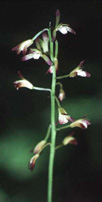Aplectrum hyemale (Muhl. ex Willd.) Torr.
Adam and Eve, putty root
Aplectrum is a monotypic genus, although an extremely similar species
(again in a monotypic genus), Oreorchis patens Lindley, is found
in Japan and far eastern Asia. The name is derived from the Greek term meaning
"spurless," apparently to distinguish it from Tipularia,
which has a similar wintergreen leaf but has spurred flowers. The specific
epithet hyemale is the Latin meaning "winter," in reference
to the wintergreen leaf of this species.


DESCRIPTION: Plant
arising from a globular tuber, the remains of the previous year's tuber
persisting. Leaf solitary, plicate, bluish-green above with white
veins, purplish green below; leaf emerging in late fall and persisting through
winter, usually senescing just before flowering. Inflorescence a
spike of 6 to 10 flowers, 13-24 cm high. Sepals oblanceolate, 10-14
mm long to 2-4 mm wide, madder-purple near the tips, green to greenish-yellow
near the base. Petals similar in size and appearance to the sepals.
Labellum 3-lobed, obovate, 10-12 mm long and 5-9 mm wide; white with
a suffusion of madder-purple near the margins, middle of the labellum with
several fleshy ridges.
SIMILAR SPECIES: I can think of no other plant in the Wisconsin flora
that can be confused with Aplectrum.
HABITAT: Aplectrum is typically found in moist, rich deciduous
woods; however, it has been collected in Wisconsin in coniferous or mixed
deciduous-coniferous woods.
FLOWERING DATES: May 25 to July 1, flowering later in the northern part
of the state.
POLLINATION: According to Hogan (1983),
the plants are autogamous. Consequently, there is nearly always very high
seed set.
DISCUSSION: The distinctive nature of the leaves of Aplectrum
and their presence during the autumn and winter means that the plant is
best searched for in the autumn and winter, particularly when there is a
light coating of snow on the ground. The plants typically grow in small
colonies, with only a few plants flowering in a season.
The name "putty root" comes from the mucilaginous fluid which
can be removed from the tubers when they are crushed. According to Correll
(1950), the fluid removed from the roots was used by early American
settlers to repair broken pottery, and by Native Americans for medicinal
purposes.

Hibernal (winter) Leaf
WI DISTRIBUTION:  U.S. DISTRIBUTION:
U.S. DISTRIBUTION:
Go directly to Wisconsin herbarium records.
Return
to the main LIST of the Orchids of Wisconsin.
Return to the main KEY to the Orchids of
Wisconsin.



 U.S. DISTRIBUTION:
U.S. DISTRIBUTION: